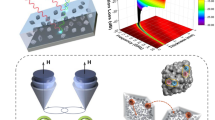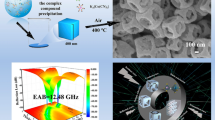Abstract
Advanced electromagnetic (EM) wave absorbing materials with strong absorption and broad bandwidth are important for military stealth and elimination of microwave pollution in consumers’ electronics. Metal organic framework (MOF)-derived metal/carbon hybrids with ordered structure are significantly urgent in this field. In this contribution, we presented a design strategy of hollow cage-like or solid box-like magnetic/dielectric Fe/Co/C and dielectric Fe/Mn/C EM wave absorbing nanomaterials via pyrolyzing Prussian blue’s analogs with controllable topology and phase composition. The solid box-like Fe/Co/C and hollow cage-like Fe/Mn/C showed favorable absorption property with a broad effective absorption bandwidth (EAB) and a low reflection loss (RL). Especially, the EAB of 8.8 GHz at a thickness of 2.5 mm for solid box-like Fe/Co/C nanocomplex prepared at 900°C is a new record for this type of materials. The design and tuning strategy for EM wave absorbers derived from topology-controllable MOF is important for EM functional materials possessing great potential in military stealth and consumers’ electronics.
摘要
装备隐身和电子器件电磁防护的发展对高带宽、 强吸收先进电磁波吸收材料具有迫切需求, 采用金属有机骨架(MOF)衍生有序结构金属/碳杂化材料是重要制备方法. 本文采用具有可控拓扑结构和微相组成的普鲁士蓝衍生物作为前驱体, 通过热解工艺制备空心、 实心的笼状、 盒状等拓扑结构Fe/Co/C和Fe/Mn/C纳米复合电磁波吸收剂. 实心Fe/Co/C和空心Fe/Mn/C均表现出强电磁吸收和高吸收带宽, 电磁波反射系数最低为−54.6 dB, 其中900°C热解制备的实心盒状Fe/Co/C吸收剂在厚度2.5 mm时有效吸收带宽高达8.8 GHz, 刷新了该类材料的性能上限. 通过控制MOF拓扑结构来设计和调控金属/碳杂化吸波剂对于新型电磁波吸收材料的发展及其在装备隐身领域的应用具有重要意义.
Similar content being viewed by others
References
Li X, Wang L, You W, et al. Morphology-controlled synthesis and excellent microwave absorption performance of ZnCo2O4 nanostructures via a self-assembly process of flake units. Nanoscale, 2019, 11: 2694–2702
Lv H, Yang Z, Wang PL, et al. A voltage-boosting strategy enabling a low-frequency, flexible electromagnetic wave absorption device. Adv Mater, 2018, 30: 1706343
Cao MS, Cai YZ, He P, et al. 2D MXenes: Electromagnetic property for microwave absorption and electromagnetic interference shielding. Chem Eng J, 2019, 359: 1265–1302
Liang C, Qin W, Wang Z. Cobalt doping-induced strong electromagnetic wave absorption in SiC nanowires. J Alloys Compd, 2019, 781: 93–100
Liu L, He N, Wu T, et al. Co/C/Fe/C hierarchical flowers with strawberry-like surface as surface plasmon for enhanced permittivity, permeability, and microwave absorption properties. Chem Eng J, 2019, 355: 103–108
Chen KJ, Madden DG, Mukherjee S, et al. Synergistic sorbent separation for one-step ethylene purification from a four-component mixture. Science, 2019, 366: 241–246
Yang QY, Lama P, Sen S, et al. Reversible switching between highly porous and nonporous phases of an interpenetrated diamondoid coordination network that exhibits gate-opening at methane storage pressures. Angew Chem Int Ed, 2018, 57: 5684–5689
Chen KJ, Scott HS, Madden DG, et al. Benchmark C2H2/CO2 and CO2/C2H2 separation by two closely related hybrid ultra-microporous materials. Chem, 2016, 1: 753–765
Manna K, Zhang T, Carboni M, et al. Salicylaldimine-based metal-organic framework enabling highly active olefin hydrogenation with iron and cobalt catalysts. J Am Chem Soc, 2014, 136: 13182–13185
Zhang L, Wu HB, Madhavi S, et al. Formation of Fe2O3 microboxes with hierarchical shell structures from metal-organic frameworks and their lithium storage properties. J Am Chem Soc, 2012, 134: 17388–17391
He Z, Dai Y, Li X, et al. Hybrid nanomedicine fabricated from photosensitizer-terminated metal-organic framework nano-particles for photodynamic therapy and hypoxia-activated cascade chemotherapy. Small, 2019, 15: 1804131
Begum S, Hassan Z, Brase S, et al. Metal-organic framework-templated biomaterials: Recent progress in synthesis, functionalization, and applications. Acc Chem Res, 2019, 52: 1598–1610
Cao C, Ma D, Xu Q, et al. Semisacrificial template growth of self-supporting MOF nanocomposite electrode for efficient electro-catalytic water oxidation. Adv Funct Mater, 2019, 29: 1807418–1807426
Liu Y, Yang Y, Sun Y, et al. Ostwald ripening-mediated grafting of metal-organic frameworks on a single colloidal nanocrystal to form uniform and controllable MXF. J Am Chem Soc, 2019, 141: 7407–7413
Lü Y, Wang Y, Li H, et al. MOF-derived porous Co/C nanocomposites with excellent electromagnetic wave absorption properties. ACS Appl Mater Interfaces, 2015, 7: 13604–13611
Zhang K, Wu F, Xie A, et al. In situ stringing of metal organic frameworks by SiC nanowires for high-performance electromagnetic radiation elimination. ACS Appl Mater Interfaces, 2017, 9: 33041–33048
Liao Q, He M, Zhou Y, et al. Highly cuboid-shaped heterobimetallic metal-organic frameworks derived from porous Co/ZnO/C microrods with improved electromagnetic wave absorption capabilities. ACS Appl Mater Interfaces, 2018, 10: 29136–29144
Feng W, Wang Y, Chen J, et al. Metal organic framework-derived CoZn alloy/N-doped porous carbon nanocomposites: Tunable surface area and electromagnetic wave absorption properties. J Mater Chem C, 2018, 6: 10–18
Liao Q, He M, Zhou Y, et al. Rational construction of Ti3C2Tx/Co-MOF-Derived Laminated Co/TiO2-C hybrids for enhanced electromagnetic wave absorption. Langmuir, 2018, 34: 15854–15863
Miao P, Cheng K, Li H, et al. Poly(dimethylsilylene)diacetylene-guided ZIF-based heterostructures for full Ku-band electromagnetic wave absorption. ACS Appl Mater Interfaces, 2019, 11: 17706–17713
Yin Y, Liu X, Wei X, et al. Porous CNTs/Co composite derived from zeolitic imidazolate framework: A lightweight, ultrathin, and highly efficient electromagnetic wave absorber. ACS Appl Mater Interfaces, 2016, 8: 34686–34698
Yin Y, Liu X, Wei X, et al. Magnetically aligned Co-C/MWCNTs composite derived from MWCNT-Interconnected zeolitic imidazolate frameworks for a lightweight and highly efficient electromagnetic wave absorber. ACS Appl Mater Interfaces, 2017, 9: 30850–30861
Shu R, Li W, Wu Y, et al. Nitrogen-doped Co-C/MWCNTs nanocomposites derived from bimetallic metal-organic frameworks for electromagnetic wave absorption in the X-band. Chem Eng J, 2019, 362: 513–524
Zhou C, Wu C, Liu D, et al. Metal-organic framework derived hierarchical Co/C@V2O3 hollow spheres as a thin, lightweight, and high-efficiency electromagnetic wave absorber. Chem Eur J, 2019, 25: 2234–2241
Yang Z, Lv H, Wu R. Rational construction of graphene oxide with MOF-derived porous NiFe@C nanocubes for high-performance microwave attenuation. Nano Res, 2016, 9: 3671–3682
Zhang Y, Zhang HB, Wu X, et al. Nanolayered cobalt@carbon hybrids derived from metal-organic frameworks for microwave absorption. ACS Appl Nano Mater, 2019, 2: 2325–2335
Wang K, Chen Y, Tian R, et al. Porous Co-C core-shell nanocomposites derived from Co-MOF-74 with enhanced electromagnetic wave absorption performance. ACS Appl Mater Interfaces, 2018, 10: 11333–11342
Wu N, Xu D, Wang Z, et al. Achieving superior electromagnetic wave absorbers through the novel metal-organic frameworks derived magnetic porous carbon nanorods. Carbon, 2019, 145: 433–444
Xiang Z, Song Y, Xiong J, et al. Enhanced electromagnetic wave absorption of nanoporous Fe3O4@carbon composites derived from metal-organic frameworks. Carbon, 2019, 142: 20–31
Zhu BY, Miao P, Kong J, et al. Co/C composite derived from a newly constructed metal-organic framework for effective microwave absorption. Cryst Growth Des, 2019, 19: 1518–1524
Liu W, Liu L, Ji G, et al. Composition design and structural characterization of MOF-derived composites with controllable electromagnetic properties. ACS Sustain Chem Eng, 2017, 5: 7961–7971
Nai J, Lou XWD. Hollow structures based on Prussian blue and its analogs for electrochemical energy storage and conversion. Adv Mater, 2019, 31: 1706825
Deng L, Yang Z, Tan L, et al. Investigation of the Prussian blue analog Co3[Co(CN)6]2 as an anode material for nonaqueous potassium-ion batteries. Adv Mater, 2018, 30: 1802510
Keggin JF, Miles FD. Structures and formulas of the Prussian blues and related compounds. Nature, 1936, 137: 577–578
Nai J, Lu Y, Yu L, et al. Formation of Ni-Fe mixed diselenide nanocages as a superior oxygen evolution electrocatalyst. Adv Mater, 2017, 29: 1703870
Li Y, Hu J, Yang K, et al. Synthetic control of Prussian blue derived nano-materials for energy storage and conversion application. Mater Today Energy, 2019, 14: 100332
Du Y, Chen J, Li L, et al. Core-shell FeCo Prussian blue analogue/Ni(OH)2 derived porous ternary transition metal phosphides connected by graphene for effectively electrocatalytic water splitting. ACS Sustain Chem Eng, 2019, 7: 13523–13531
Miao P, Zhou R, Chen K, et al. Tunable electromagnetic wave absorption of supramolecular isomer-derived nanocomposites with different morphology. Adv Mater Interfaces, 2020, 7: 1901820
Qiang R, Du Y, Zhao H, et al. Metal organic framework-derived Fe/C nanocubes toward efficient microwave absorption. J Mater Chem A, 2015, 3: 13426–13434
Liu D, Qiang R, Du Y, et al. Prussian blue analogues derived magnetic FeCo alloy/carbon composites with tunable chemical composition and enhanced microwave absorption. J Colloid Interface Sci, 2018, 514: 10–20
Panwar R, Puthucheri S, Singh D. Experimental demonstration of novel hybrid microwave absorbing coatings using particle-size-controlled hard-soft ferrite. IEEE Trans Magn, 2018, 54: 1–5
Zhou M, Zhang X, Wei J, et al. Morphology-controlled synthesis and novel microwave absorption properties of hollow urchinlike α-MnO2 nanostructures. J Phys Chem C, 2011, 115: 1398–1402
Zhao B, Zhao W, Shao G, et al. Morphology-control synthesis of a core-shell structured NiCu alloy with tunable electromagnetic-wave absorption capabilities. ACS Appl Mater Interfaces, 2015, 7: 12951–12960
Nai J, Zhang J, Lou XWD. Construction of single-crystalline Prussian blue analog hollow nanostructures with tailorable topologies. Chem, 2018, 4: 1967–1982
Zheng F, Zhu D, Shi X, et al. Metal-organic framework-derived porous Mn18Fe12O4 nanocubes with an interconnected channel structure as high-performance anodes for lithium ion batteries. J Mater Chem A, 2015, 3: 2815–2824
Cai X, Gao W, Ma M, et al. A Prussian blue-based core-shell hollow-structured mesoporous nanoparticle as a smart theranostic agent with ultrahigh pH-responsive longitudinal relaxivity. Adv Mater, 2015, 27: 6382–6389
Zakaria MB, Hu M, Hayashi N, et al. Thermal conversion of hollow Prussian blue nanoparticles into nanoporous iron oxides with crystallized hematite phase. Eur J Inorg Chem, 2014, 2014: 1137–1141
Zhu T, Chang S, Song YF, et al. PVP-encapsulated CoFe2O4/rGO composites with controllable electromagnetic wave absorption performance. Chem Eng J, 2019, 373: 755–766
Song Y, He L, Zhang X, et al. Highly efficient electromagnetic wave absorbing metal-free and carbon-rich ceramics derived from hyperbranched polycarbosilazanes. J Phys Chem C, 2017, 121: 24774–24785
Liu S, Liu J, Dong X Electromagnetic Shielding and Absorbing Materials. 2nd ed. Beijing: Chemical Industry Press, 2014, 418
Zhao Y, Liu L, Jiang K, et al. Distinctly enhanced permeability and excellent microwave absorption of expanded graphite/Fe3O4 nanoring composites. RSC Adv, 2017, 7: 11561–11567
Luo C, Jiao T, Gu J, et al. Graphene shield by SiBCN ceramic: A promising high-temperature electromagnetic wave-absorbing material with oxidation resistance. ACS Appl Mater Interfaces, 2018, 10: 39307–39318
Luo C, Tang Y, Jiao T, et al. High-temperature stable and metal-free electromagnetic wave-absorbing SiBCN ceramics derived from carbon-rich hyperbranched polyborosilazanes. ACS Appl Mater Interfaces, 2018, 10: 28051–28061
Li J, Miao P, Chen KJ, et al. Highly effective electromagnetic wave absorbing prismatic Co/C nanocomposites derived from cubic metal-organic framework. Compos Part B-Eng, 2020, 182: 107613
Acknowledgements
This work was financially supported by the National Natural Science Foundation of China (21875190), Polymer Electromagnetic Functional Materials Innovation Team of Shaanxi Sanqin Scholars, the Natural Science Basic Research Plan in Shaanxi Province of Distinguished Young Scholar (2018JC-008), and China Postdoctoral Science Foundation (2018M643724).
Author information
Authors and Affiliations
Contributions
Author contributions Kong J and Chen KJ designed the experiments Kong J led the project. Miao P and Chen J conducted and performed the experiments. Kong J, Chen KJ and Tang Y analyzed the data. Miao P, Kong J and Chen KJ wrote the manuscript. All authors contributed to the general discussion.
Corresponding author
Ethics declarations
Conflict of interest The authors declare that they have no conflict of interest.
Additional information
Peng Miao received his master degree in materials physics and chemistry from Chang’an University in 2014. He is currently a PhD candidate majored in chemistry under the supervision of Prof. Jie Kong at Northwestern Polytechnical University. His research interest mainly focuses on the synthesis of metal-organic frameworks and their applications in electromagnetic absorption and shielding.
Jie Kong received his PhD degree from Northwestern Polytechnical University in 2004. He then went to The Hong Kong Polytechnic University as a postdoctoral fellow and the University of Bayreuth as an Alexander von Humboldt research fellow. In 2011, he joined the School of Science at Northwestern Polytechnical University as a full professor. His research interests include hyperbranched polymers, metal-organic frameworks, ceramic precursors and electromagnetic absorbing/transmitting materials.
Rights and permissions
About this article
Cite this article
Miao, P., Chen, J., Tang, Y. et al. Highly efficient and broad electromagnetic wave absorbers tuned via topology-controllable metal-organic frameworks. Sci. China Mater. 63, 2050–2061 (2020). https://doi.org/10.1007/s40843-020-1333-9
Received:
Accepted:
Published:
Issue Date:
DOI: https://doi.org/10.1007/s40843-020-1333-9




